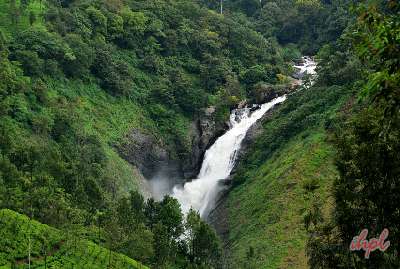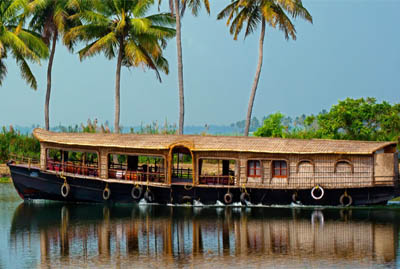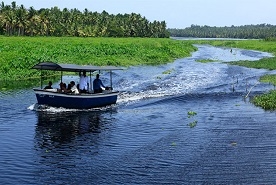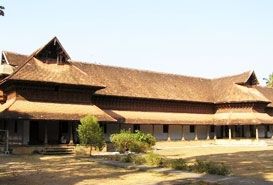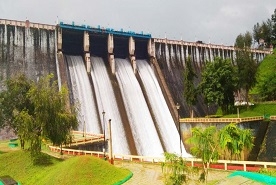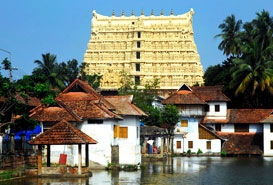Padmanaswamy Temple in Thiruvananthapuram is wealthy and one of the oldest temples in Thiruvananthapuram (Trivandrum), which attracts pilgrims and tourists annually. It is dedicated to Lord Padmanabha (Vishnu) and built with its brilliant Dravidian architecture.
This is one of 180 Divya Desams in India, which are the holiest abodes of Lord Vishnu. The presiding deity in the temple is Lord Vishnu reclining on a hooded serpent known as Anantha. One of its notable features is the seven-tiered gopuram with a height of 100 feet.
The gopuram was built around 1566 in Pandyan style. Stretching from the eastern sides of the temple, the corridor leads to the grand sanctum; the corridor's detailed carvings and sculptures add to the beauty.
Check out Kerala Tour Packages, Mararikulam Tour Packages, Varkala Tour Packages
The Idols of Padmanaswamy Temple
The main deity inside Padmanabhaswamy Temple is Lord Vishnu (Lord Padmanabha), reclined on a five-hooded serpent, Anantha. Anantha has spread its hoods above the deity. Five hoods of the serpent represent five senses, Panchedriyas, and five elements known as Panchabhootas.
The lord has his head positioned to the south, and his feet point to the north. Three coils are symbolic of characteristics of mankind, namely Sattwa, Rajas, and Tamas. Emerging from his navel is a lotus upon which Lord Brahma is seated. Lord Shiva's lingam is placed below his right arm.
The three lords combine to represent Srushti, Stithi, and Samharam. There are three doors only through which you can behold the deity, and this too has significance as it is symbolic of the three stages of times.
Other idols in Padmanabhaswamy Temple consist of Sree Ramaswamy with his consort Seetha and brother Lakshmanan, Sree Veda Vyasa and Ashwathama, Vishwaksenan, Sree Yoga Narasimha Moorthi, Thiruvambadi Sreekrishnaswamy, Kshethrapaalakan, Agrashaala Ganapathi, Sree Dharma Sastha, Hanuman Swamy, Ashtanga Garuda Swamy, and the Maha Meru Chakram.
Check out Palakkad Tour Packages, Kumarakom Tour Packages, Periyar Tour Packages
Significance of Padmanabhawamy Temple
This is one of the most famous temples in Thiruvananthapuram and has its reference in holy texts like Srimad Bhagvat Gita. According to Bhagwad Gita, Balarama visited this temple and made offerings after bathing in Padmatheertham. A poet from the 9th century, Nammalwar, composed ten hymns to praise Lord Padmanabha.
History of Padmanabhawamy Temple
Many historians and writers have stated that this temple was established at the beginning of the Kali Yug. If this statement is to be believed, the temple is 5000 years old. However, no reliable documentation has yet been found that tells when and by who the temple was commissioned.
On the old palm leaf records of the temple, another popular legend named 'Ananthasayana Mahatmya' is found. It is said that this story was consecrated by Divakara Muni, a staunch follower of Lord Vishnu. According to the story, when Divakar Muni was in deep tapas, he saw Lord Vishnu appear in front of him in the form of a child.
He requested the child to stay with him, but the child put a condition for the same. He said the saint must be respectful towards him; if he didn't, the child-god would disappear in a minute.
Divakar Mani agreed. One day when he was in deep meditation, the child took a scalogram of the sage and started putting it in his mouth. This made the sage very angry, and he scolded the child, and according to the condition, he disappeared. While going away, the child (Lord Vishnu) instructed the sage to find him in Ananthankaadu.
After a few days, the sage proceeded to find the child. He reached a forest near the sea and caught sight of the child disappearing into the Ilappa tree. The tree fell to the ground in a short while and assumed Maha Vishnu's form. Sage offered prayers to the tree and asked if he could condense himself to see him.
Lord agreed and shrunk into a size thrice the length of the sage's yoga dand. Then, the sage offered mangoes in a coconut shell. Lord Vishnu ordered that prayers to him must be provided to him by Tula Brahmins like Divakar Muni.
Explore 3 nights 4 days Kerala Luxury backwaters tour package, Alleppey tour package for 2 days
Aesthetics and Architecture of Padmanabhawamy Temple
Padmanabha Swamy Temple is inspired by the Dravidian architectural style, with stone and bronze embellishments. Its gopuram has a height of 100 ft. Murals and paintings adorn the interiors. Dhwaja Stambha (flag-post) at the entrance is covered with copper sheets plated with gold and stands 80 ft tall. Bali Peeda Mandapam and Mukha Mandapam are two halls portraying exquisite structural features. These halls are decorated with sculptures of Hindu deities.
Navgraha Mandapa has its ceiling decorated with nine planets of the solar system. The corridor, extending from the entrance to the sanctum sanctorum, has its wall carved with granite sculptures.
Festivals in Padmanabhawamy Temple
Many festivals are hosted in the temple, and the most important ones occur annually. The major festival of Padmanabha Swamy Temple is Navaratri Festival, which lasts for 9 days. During these 9 days, the famous Swathi Music Festival is organized here.
The ground floor below gopuram is called nataka sala, which also happens to be the venue of the ten-day festival Uthsavam. This is a famous festival in Kerala and takes place twice a year.
Browse through our Kerala Tour Packages from Ahmedabad
Timings of Worship in Padmanabhawamy Temple
Morning Pooja:
- 03:30 am. to 04:45 am. (Nirmalya Darshanam)
- 06:30 am. to 07:00 am.
- 8.30 am. to 10:00 am.
- 10:30 am. to 11:10 am.
- 11:45 am. to 12:00 Noon
Evening Pooja:
- 05:00 pm. to 06:15 pm.
- 06:45 pm. to 07:20 pm.
Padmanabhaswamy Temple Entry Fee and Pooja Charges
Entry Fee : Free
- 150 per person for Special Darshan
- 180 per person for Special Darshan with Prashad
How to Reach
It is located in Pazhavangadi and is only 1 km from the Thiruvananthapuram railway station. After reaching the railway station, you can take a cab or a rickshaw to reach this temple. Trivandrum International Airport is located around 6 km from this temple, and you can easily cover this distance by taxi, cab, or bus.




